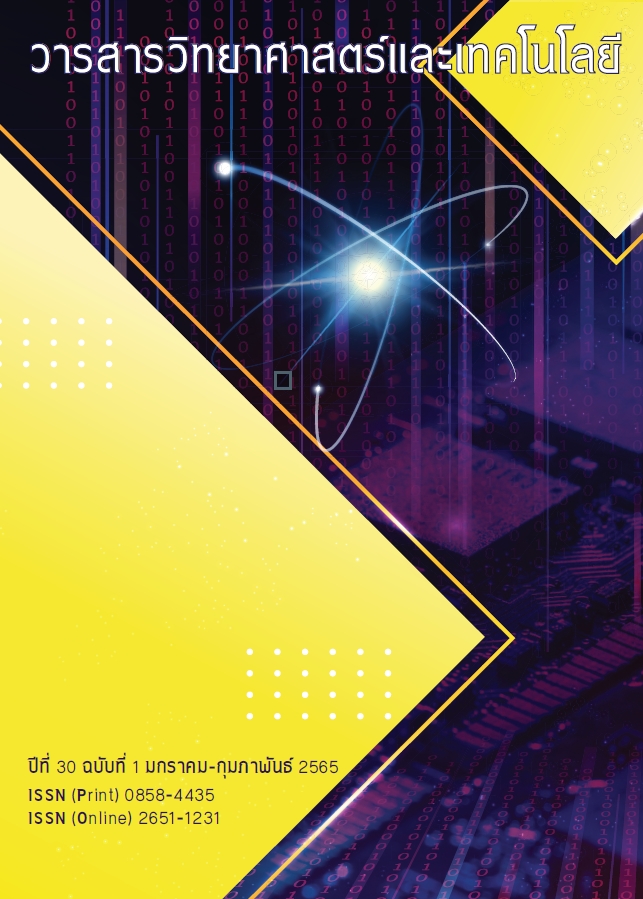Enzyme and Non-enzyme Antioxidant Activities of Cherry Tomato, Sida Pink Tomato and Big Red Tomato Fruit Extracts
Main Article Content
Abstract
Tomatoes are considered a nutritious fruit. Each tomato species has a different wide variety level of antioxidants. It is commonly eaten fresh and processed into various health products. In this present study, we aimed to compare the antioxidant capacities of three types of tomato fruit extracts (cherry tomato, Sida pink tomato, and big red tomato). We conducted measurement on vitamin C content, non-enzymatic antioxidant activity by ferric reducing-antioxidant power (FRAP) assay and DPPH (free radical scavenging) method, and enzyme activity measurement by superoxide dismutase (SOD) and catalase methods. The results showed that all three types of tomatoes contain both enzyme-based and non-enzymatic antioxidants. Cherry tomato consisted of the highest vitamin C content. Sida pink and big red tomatoes were observed equally contained vitamin C when using the same amount of gram weight. Cherry tomato fruit showed the highest percentage of free radical inhibition of SOD as 53% by water extract, and the highest catalase enzyme activity as 31 M by ethanol extract. In comparison, Sida pink tomato fruit of ethanol extract suggested the greatest level of antioxidant FRAP value as 62 mg/mL. Big red tomato showed IC50 of DPPH as 0.59 μg/mL with the best results using ethanol extract. Based on the different antioxidant properties of each tomato could lead to further gain in selective tomato consumption. Thus, the processing method on the extract enhances bioactive and value of products that could improve protective consequence directly on health and goal of treatment.
Article Details
References
Noori, S., 2012, An Overview of Oxidative Stress and Antioxidant Defensive System, Open Access Sci Rep. 1(8): 2-9.
Sarms, A.D., Mallick, A.R.., and Ghosh, A.K., 2010, Free radicals and Their Role in Different Clinical Conditions: An Overview, Int J Phar Sci and Res. 1(3): 185-192.
Rahman, T., Hosen, I., Towhidul Islam, M.M., and Shekhar, H.U., 2012, Oxidative stress and human health, Advances in Biosci and Biotech. 3: 997-1019.
Valko, M., Leibfritz, D., Moncol, J., Cronin, M.T.D., Mazur, M, and Telser, J., 2007, Free radicals and antioxidants in normal physiological functions and human disease, Int J Biochem Cell Biol. 39(1): 44-84.
del Rio, L.A., 2015, ROS and RNS in plant physiology: an overview, J Exp Bot. 66(10): 2827-2837.
Sarah, C.D, Sandra, K., and Iris, E.P., 2003, Taxonomy of tomatoes in the Galápago Islands: Native and introduced species of Solanum section Lycopersicon (Solanaceae), J Syst Biodivers. 1: 29-53.
Alda, L. M., Gogoasa, I., Bordean, D., Gergen, I. Alda, S., Moldovan, C., and Nita, L., 2009, Lycopene content of tomatoes and tomato products, J Agroalim Process and Tech. 15(4): 540-542.
Thamwiriyasati, N., Khumkhana, N., Innok, P., and Chonanant, C., 2017, In Vitro Antimicrobial Activities of Natural Extracts of Sida Tomato and Cherry Tomato against Microbial Pathogens, Srinagarind Med J. 32(4): 359-365. (in Thai)
Ronald, R.E., Lin, Y., and Landen, W.O, 2008, Vitamin analysis for the health and food sciences, United States of American on acid-free paper. 662 p.
Thaipong, K., Boonprakob, U., Crosby K.,Cisneros-Zevallos, L., and Byrne, D.H., 2006, Comparison of ABTS, DPPH, FRAP, and ORAC assays for estimating antioxidant activity from guava fruit extracts, J Food Composition and Analysis. 19:
-675.
Benzie, I.F.F., and Strain, J.J., 1996, The ferric reducing ability of plasma (FRAP) as a measure of "antioxidant power": the FRAP assay, Anal Biochem. 239: 70-76.
Nebot, C., Moutet, M., Huet, P., Xu, J.Z., Yadan, J.C., and Chaudiere, J., 1993, Spectrophotometric Assay of Superoxide Dismutase Activity Based on the Activated Autoxidation of a Tetracyclic Catechol, Anal Biochem. 214: 442-451.
Aebi, H., 1984, Catalase in vitro, Meth Enzym. 105: 121-126.
Riso, P., Visioli, F., Erba, D., Testolin, G., and Porrini, M., 2004, Lycopene and vitamin C concentrations increase in plasma and lymphocytes after tomato intake. Effects on cellular antioxidant protection, Eur J Clin Nutr. 58(10): 1350-1358.
Kukongviriyapan, V., 2014, Essential role of antioxidant network of vitamins and enzymes, Srinagarind Med J. 29(1): 59-70. (in Thai)
Feng, K., Yu, J., Cheng, Y., Ruan, M., Wang, R., Ye, Q., Zhou, G., Li, Z., Yao, Z., Yang Y., Zheng, Q., and Wan, H., 2016, The SOD Gene Family in Tomato: Identification, Phylogenetic Relationships, and Expression Patterns. Front Plant Sci. 7: 1279.
Gratão, P.L., Monteiro, C.C., Peres, L.E.P. and Azevedo, R.A., 2008, The Isolation of Antioxidant Enzymes from Mature Tomato (cv. Micro-Tom) Plants, Hort Sci. 43(5):1608-1610.
Giovannucci, E., 1999, Tomatoes, tomato-based products, lycopene, and cancer: review of the epidemiologic literature, J Natl Cancer Inst. 91(4): 317-331.
Bruijn, L.I., Houseweart, M.K., Kato, S., Anderson, K.L., Anderson, S.D., Ohama, E., Reaume, A.G., Scott, R.W., and Cleveland, D.W., 1998, Aggregation and motor neuron toxicity of an ALS-linked SOD1 mutant independent from wild-type SOD1. Science. 281: 1851-1854.
Hemathulin, S., and Techawongstien, S., 2016, The effecting of varieties on radical scavenging and antioxidant activity of cherry tomato (Lycopersicon esculentum), KHON KAEN AGR. J. 44: SUPPL.1. (in Thai)
Toor, R.K., and Savage, G.P., 2005, Antioxidant activity in different fractions of tomatoes. Food Res Int. 38: 487-494.


